- What is the importance of Kartik Poornima & are rules on this day? On this day Kartikeya was born? What is Tripuri Poornima? Why is Bhishma worshipped on this day? Kanchi Paramacharya Sri Chandrasekarendra Saraswathi on Kartik Purnima.
The eighth lunar month in Hindu calendar is Kartika which is considered as the most sacred month among all months. The greatness of Kartik month is described in Skanda Purana, Narada Purana, Padma Purana. Sri Krishna says, “Of all plants, the sacred Tulasi is most dear to Me; of all months, Kartika is most dear, of all places of pilgrimage, My beloved Dwarka is most dear, and of all days, Ekadashi is most dear.” (Padma Purana, Uttara Khand 112.3).
According to Padma Purana, Satyabhama received the honour of being Krishna's consort by performing Ekadashi and Kartika Vrat in a previous birth. From the point of view of fasting and austerity, Kartik is considered as the most benevolent, best and rare month.
The following sloka in Skanda Purana states
that a person who fasts and does penance in Kartika maas attains liberation.
Kartika is also great and rare like Sri Vishnu and Vishnutirtha.
मासानां कार्तिक: श्रेष्ठो देवानां मधुसूदन।
तीर्थं नारायणाख्यं हि त्रितयं दुर्लभं कलौ।।
(स्कंद पुराण, वै. खं. कां. मा. 1/14)
“Maasanaam
kartikah shreshtho devanam madhusudana,
Teertham
narayanaakhyam hi tritayam durlabham kalau”
Kartika is the only month in which both Bhagwan Siva and Bhagwan
Vishnu are worshipped. The full moon day of Kartika is called
Kartika Pouranmi or Kartika Poornima. A sloka of Skanda
Purana describes the importance of Kartika, “There is no other month equal to Kartika, no era like Satyayuga, no scripture equal to Vedas and no other place of pilgrimage equal to Ganges, therefore, the month of Kartika is very dear to the Vaishnavas”.
न कार्तिकसमो मासो न कृतेन समं युगम्।
न वेदसदृशं शास्त्रं न तीर्थं गङ्गाय समम्।।
“Na kartiksamo maaso na kriten samam yugam,
Na
vedsadrisham shaastram na teertham gangayaa samam”
Kartika Poornima is the birthday of Matsya, Bhagwan Vishnu's fish-incarnation (Matsya Avatar). It is the day on which Vishnu incarnated as Matsya
to save Manu from the Maha Pralaya (dissolution of the universe).
It is also the birthday of Vrinda, the
personification of Tulasi plant. This day also is considered special for Radha,
the lover of Krishna. It is believed
that Krishna and Radha danced rasa and Krishna worshipped Radha on this day. On this day Kartikeya, the deva of war and son of Siva
was born.
On Kartik Poornima, prayers are offered to Siva’s son Kartikeya. It relates to the story of Ganesha and Kartikeya vying to become supreme in a race and Ganesha winning it by simply circling around his parents while Kartikeya went around the world. To appease an annoyed Kartikeya, an entire month is dedicated to Shiva's prodigal son. This day is also dedicated to the pitrs, dead ancestors.
Kartika maas begins
with Sharad Purnima and ends on Kartik Purnima. In this month many
special festivals like Karva Chauth, Dhanteras, Roop Chaudas, Deepawali,
Govardhan Puja, Bhaiya Dooj, Amla navmi, Dev Uthaoni Ekadashi, Vishwakarma Diwas etc are celebrated. On Vishwakarma Diwas machines, tools, etc are worshipped and given
their due respect. All factory workers, labourers or farmers worship their
equipment on this day and do not do any work.
Devuthaoni Ekadashi signifies waking up of Vishnu
Bhagwan and all Devi devatas after chaturmaas (four month long sleep of Devi
devatas). When Devi devatas are awake, auspicious celebrations like marriage,
griha pravesh, etc begin. 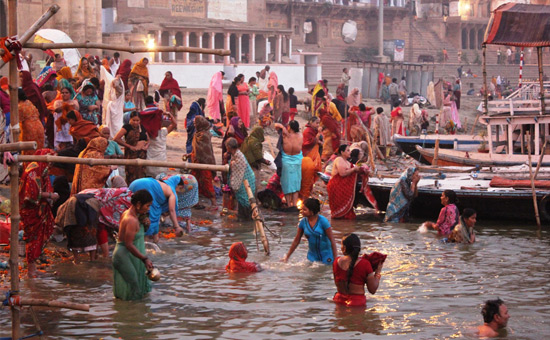 Women bathing at Assi ghat, Kashi before sunrise.
Women bathing at Assi ghat, Kashi before sunrise.
As per Padma Purana, rules of Kartika include getting up and bathing at
Brahma Muhurta when stars are still visible in sky, nurturing the Tulsi mata, lighting
diyas in front of Siva and Krishna, fasting the whole month by eating once a
day, reading Gita, Bhagavata-Purana, doing sankirtana before Krishna, doing Varuna
Snan, i.e. bathing in Yamuna river, doing parikrama of holy places like Sri
Radhakund in Braj. margin-left:4.5pt;margin-bottom:.0001pt;text-align:justify'>
The last five days of Kartika starting
from Prabodhini Ekadashi and concluding on Kartika Poornima are called Bhishma
Panchaka/Vishnu Panchaka.
The story behind this is related to Bhishma Pitamah. Krishna took all the five Pandavas to Bhishma Pitamah who was lying on a bed of arrows, and requested Pitamah for a sermon on how to live a dharmic life. Bhishma Pitamah preached on Raj Dharma, Varna Dharma, Moksha Dharma etc for five days. Hearing his sermon, Shri Krishna said, 'Father! I am very happy with the religious teachings you have given in the five days from Shukla Ekadashi to Purnima. I establish Bhishma
Panchak Vrat in your name. Those who do this will enjoy various pleasures throughout their life and ultimately attain salvation.'
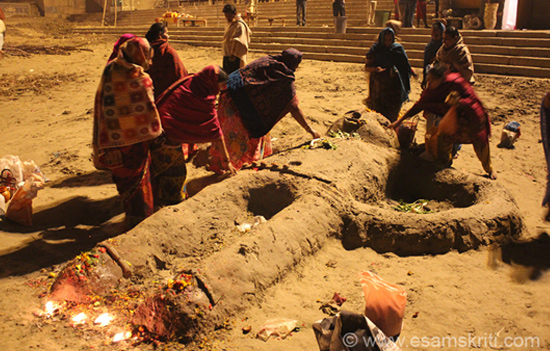 Devotees offering respects to Bhishma Pithama, Assi Ghat, Kashi. 2013.
Devotees offering respects to Bhishma Pithama, Assi Ghat, Kashi. 2013.
Rules of Bhishma Panchaka are: - giving up food, consuming only tubers, fruits, milk for five days; lighting diya under Tulasi for five days; doing tarpan for Bheeshma Pitamah for five days; lighting diyas under peepal tree daily in the name of Bhishma Pitamah; lighting Akhand Jyoti for five days and reciting Bhagvad Geeta for five days. On fifth day, Havan should be performed and Satya Narayana should be worshipped. In these 5 days don’t insult any elder even by mistake.
Tulasi Vivah is performed on any day
between Prabodhini Ekadashi to Kartika Poornima. It is a symbolic ceremonial
marriage of Tulsi with Shaligrama, a representation of Krishna. Tulasi Vivaha signifies the end of monsoon, and beginning
of Hindus wedding season. Devotees light diyas in front of Tulasi plant,
where idols of Radha and Krishna are kept. About
Tulsi Vivaha
A day before Kartika Poornima is called Vaikuntha Chaturdashi. It is believed that Sri
Vishnu worshipped Bhagwan Siva on Vaikuntha Chaturdashi, during Shukla Paksha,
by offering him one thousand lotus flowers. Siva temples on this day perform
special Puja where Vishnu and Siva are worshipped together.
Dev Diwali, the
Diwali of Devatas is celebrated on Kartika Poornima. It is believed that on
Kartika Poornima, gods descend on earth and reside in sacred rivers.
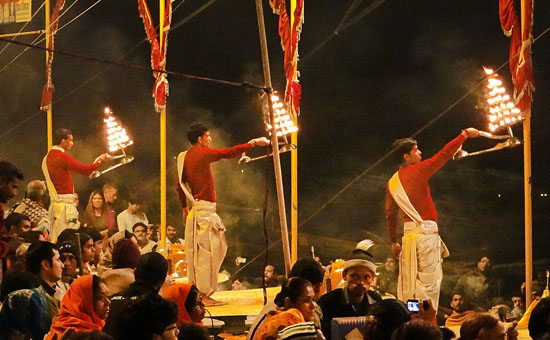 Ganga Aarti, Kashi on Dev Diwali.
Ganga Aarti, Kashi on Dev Diwali.
Ganges and other sacred rivers are lit
and worshipped with ceremonies on this day. Devotees bathe in sacred rivers on
this day to receive blessings from the Divine. It is believed that Bhagwan
Vishnu returns to his abode on this day, after completing his stay in Bali.
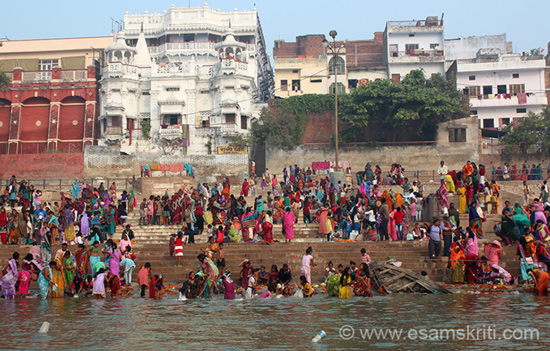 Kartik Snan in the Ma Ganga at Kashi. 2013.
Kartik Snan in the Ma Ganga at Kashi. 2013.
A ritual holy bath at a tirtha (a pilgrimage) is prescribed on Kartika Poornima, known as Kartika snana. Kartika Snan is considered equivalent to performing
100 Ashvamegha Yagya. A holy bath at Pushkar or in Varanasi is considered most
auspicious.
Devotees bathe at holy rivers and lakes
across the country on this day and fast for the whole day. It is believed that
by Kartik Snan one gets a lot of virtue and if it is done on Kartika Purnima
the virtue is multi-folded. Tripura Poornima Snan, in Varanasi in the holy
Ganges, is believed to grant liberation.
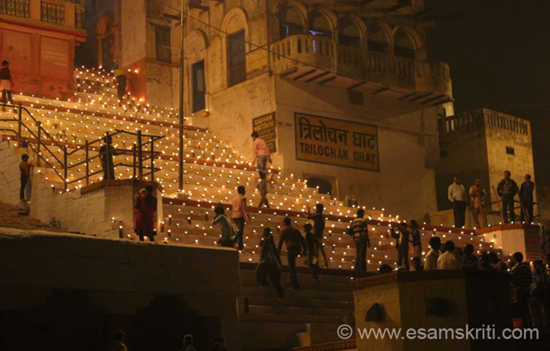 Diyas on ghats of Ma Ganga in Kashi. 2013.
Diyas on ghats of Ma Ganga in Kashi. 2013.
The steps of all ghats of Ganga Maiyya
in Varanasi are lit with diyas. Lights are floated in paper boats in rivers.
Lights are placed under peepal, Tulsi and Amla trees. Devotees light 365 wicks
in temples. Each wick is for each day of the year. Those who are near the
sacred rivers light a pack of 365 wicks on the floats made from the stems of
the Banana Tree and set them float on the river.
Another name of Kartik Poornima is Tripuri Poornima or Tripurari Poornima. Tripurari
is an epithet of Siva. Bhagwan Siva is called Tripurantaka (Killer of
Tripurasura) as he killed Tripurasura on this day. Tripurari Poornima is as
auspicious as Maha Shivaratri.
In Mahabharata there is an episode that demon Taraka
had three sons Taraksha, Kamalaksha and Vidyunmali. They did severe penance for
Brahma and asked for a boon that they would live for a thousand years in three
invincible, moving cities known as Tri (three) Puri (cities) and could be
destroyed only by one arrow that would merge the three cities into one, and set
them to fire. Their cities were made of gold, silver and iron respectively.
These cities never remained in one place long enough so it was difficult to
destroy them together. After one thousand years, the devatas approached Rudra
(Siva) for destroying the demons. Siva did his dance of destruction- Tandava.
The Tandava dance caused an earthquake which moved the three cities,
immediately Siva shot an arrow bringing the three cities in one line, and the
fire from his third eye burnt the three cities and the demons.
To commemorate the killing of
Tripurasura, images of Siva
are carried in procession. Temple complexes in southern India are lit up
throughout the night. Deepmalas or towers of lights are illuminated in temples.
In Varanasi, ghats come alive with thousands of diyas People donate diyas to
priests. Diyas are lit throughout the night in houses and Siva temples.
Worship of Vishnu is done with flowers,
diyas and incense sticks, fasting, reciting the Satyanarayan Vrat Katha.
Worship of Siva is done by performing Rudrabhishek, chanting Rudra Namakam and
Rudra Chamakam eleven times.
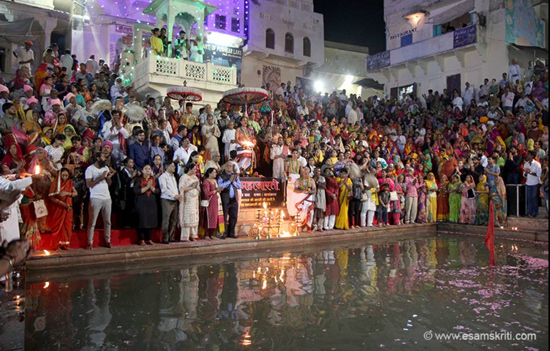 Mahaarti at Pushkar during Kartik Purnima mela.
Mahaarti at Pushkar during Kartik Purnima mela.
Kartik Purnima Mela is organized in
Pushkar, known as Pushkar fair, during the
Kartik month. This fair concludes on the day of Kartik Purnima with devotees
taking the sacred dip on the Pushkar Lake for liberation.
To
see album of Pushkar during Kartik Purnima week
In Gaudiya Vaishnava tradition Kartika maas is also
known as Damodara maas. This month is called Damodara
maas because Baby Krishna performed the Damodar Lila in this month. Damodara Leela is narrated in Srimad Bhagavatam by Sri Shukadev. One morning in Gokula, Yashoda was busy churning the curd while baby Krishna was sleeping. The sound of churning along with jingling sound of Yashoda’s bangles woke up little Krishna. A sleepy Krishna climbed on Yashoda’s lap and Maiyya began feeding him. Suddenly she noticed boiling and overflowing milk in the kitchen and hurriedly placing Krishna down, ran into the kitchen. Krishna became so annoyed that he broke the churning rod, threw the curd pot, and bit the rope into pieces. Krishna took the pot of butter in a corner and began sharing it with his monkey friends. Seeing the smashed pot, curd all over the floor, broken churning rod and Krishna’s foot prints on floor soaked in curd, Yashoda was very angry. She ran to catch naughty Krishna with a stick in her hands.
An amused Sri Shuka narrates, “Yashoda is trying to catch hold of that Supreme Being whom even the great Yogis cannot capture in their minds.” Seeing Krishna crying in fear, Yashoda dropped the stick and decided to punish Krishna by tying Him to the mortar. Seeing his mother exhausted by running, Krishna allows Yashoda to catch him thus showing that he can be attained only through Grace and not by our efforts.
Shukadev writes, “He who pervades all space and time, who has nothing exterior or interior to Him, who exists before and after; inside as well outside the universe and is indeed the universe itself, with nothing in the world that is other than Him to bind Him at all, that Para Brahman was being bound by this cowherd woman!”
When Yashoda started tying Krishna the rope fell short of two inches. Yashoda joined another rope but that also fell short of two inches. She joined all the ropes at her home but still that long rope fell short of two inches. Seeing this leela, the gopis laughed. Taking pity on Maiyya, Krishna allowed himself to be bound. Shukadev writes, “This supreme blessing that Bhagavan showered on Yashoda, that neither Brahma, nor Lord Shiva nor Goddess Sri was bestowed with.” Finally Yashoda tied Krishna to the mortar and Krishna became ‘Damodara’ (‘Dama’ in sanskrit means rope and ‘Udara’ means waist). ‘Damodara’ is one of the thousand names in Vishnu Sahasranam. Bhaktas say that even now Krishna has this mark of the rope in his belly.
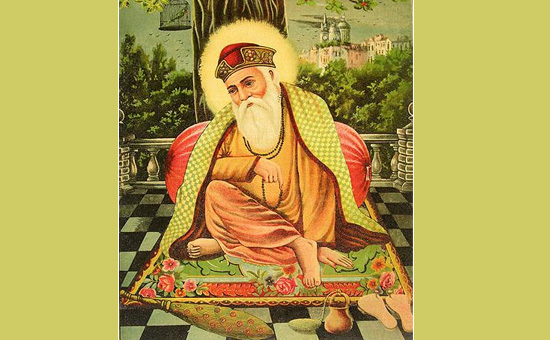 Guru Nanak Jayanti falls on Kartik Poornima.
Guru Nanak Jayanti falls on Kartik Poornima.
Kartika Poornima is also a special day
for the Sikhs as it is the birth day of Sri Guru Nanak and is celebrated with
great devotion, pomp and show. It is called Guru Nanak Jayanti, Gurpurab,
Prakash Utsav. Guru Nanak ji, was born on Kartika Poornima in 1469 AD.
Deepam
Day - the full moon of the month of Kartikai – is the most holy to Hindus in the South. The holy beacon is lighted on the top of Arunachala, the Hill of Fire, which symbolizes the light of the Spirit in all hearts and in the universe. Arunachala, another name of Shiva, enthralled Sri Maharshi, when he was a mere youth in his teens and made him substance of His substance and indistinguishable from His Essence. Arunachala, a mere hill of stones, remained for him the blissful Universal Self and the Living Guru, both in one. Every year, this day has been celebrated in Ramana ashram, tiruvannamalai with illumination, prayers, reading of the Vedas, and devotional songs, followed by distribution of several kinds of prasadam.
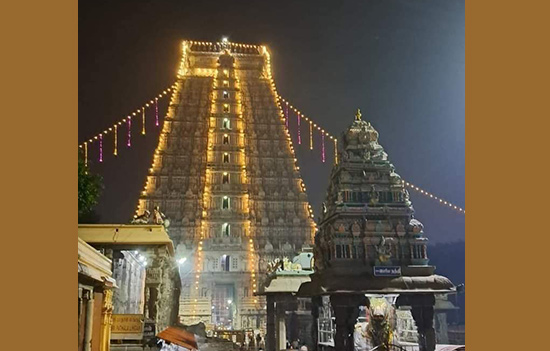 Temple at Tiruvannamalai. Courtesy Ramana Maharshi Ashram.
Temple at Tiruvannamalai. Courtesy Ramana Maharshi Ashram.
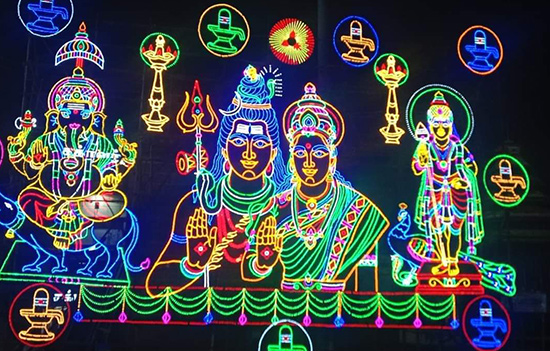 Courtesy Ramana Maharshi Ashram.
Courtesy Ramana Maharshi Ashram.
In a response to a devotee’s query about the significance of Deepam Day, Bhagavan Ramana Maharshi wrote-
To
make the intellect rid of the sense
‘I am the body’ and to introspect
By fixing it securely in the Heart,
And so perceive the true light of the SELF,
The one ‘I-I’, which is the ABSOLUTE,
This the significance of witnessing,
The Beacon Light of Arunachala,
The centre of the earth.
Describing Kartika maas in a lecture, Kanchi Paramacharya, Jagadguru Sri Chandrasekarendra Saraswathi in Chennai on 6th December 1957; Page 124 of Acharya’s Call: Madras Discourses (1957-1960),Part 1, BG Paul and Co, 1964, said,
“The Lighting of oil lamps (deepam), at sunset on the full moon day in the month of Karthigai (November-December), is an ancient practice which is in vogue throughout country from the Himalayas to Kanyakumari. It is prescribed in our Sastras (scriptures) that while lighting the deepam (lamp) on this day, we should mentally consecrate it as the abode of Sri Damodara and Sri Tripurantaka along with Sri Uma. This is done in the same way as we invoke the ‘sannidhyam’ (in-dwelling) of a chosen deity in a saligrama, linga, or sila(icon) or in a picture and invoke the grace of the Lord on us.
The idea in lighting the deepam
with such consecration is that every person who sees the light and every living
creature, worm, insect, bird, beast or plant, on which the lustre of the deepam
falls, will be suffused with the presence of God and will be blessed by Him. The following prayer is accordingly recited when lighting the Karthigai Deepam”-
“Keetah
pathangah masakascha vrikshah
Jale
sthale ye nivasanti jeevah:
Drstva
pradeepam nacha janmabhagina:
Bhavanti nityam svapachahi vipraa:”
‘We light bonfires (chokka panai), before temples on this night so that its blaze can be seen for a great distance around and God’s grace may descend on all those who behold it. Annamalai deepam at Arunachala (Tiruvannamalai) is seen for miles around. It is significant that the Karthigai Deepam festival is observed in both Saivite and Vaishnavite temples, as there is the ‘avahana’ or indwelling in the light of both Damodara and Tripurantaka, illustrative of the non difference of Siva and Vishnu’.
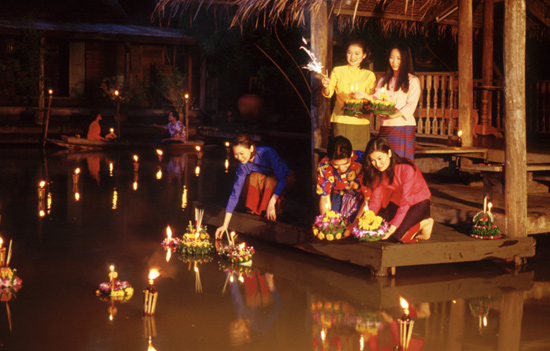 Kartik Poornima is celebrated as Festival of Lights in Thailand or Koy Krathong
Kartik Poornima is celebrated as Festival of Lights in Thailand or Koy Krathong
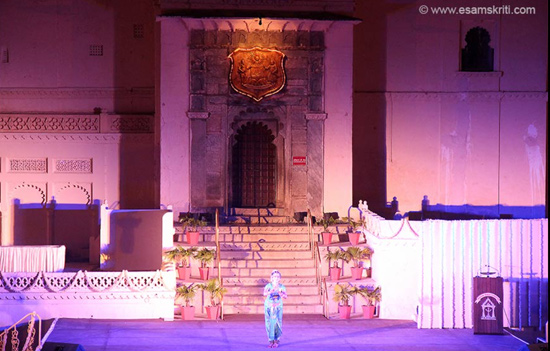 ity Palace Udaipur celebrates Kartik Purnima with a program on performing arts. 2017.
ity Palace Udaipur celebrates Kartik Purnima with a program on performing arts. 2017.
Author Seema Burman contributes articles to
Speaking Tree and esamskriti
To read all articles
by author